P-51 Mustang 1946-1952
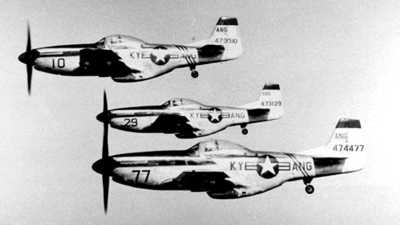
F-51Ds carrying special markings for a military exercise, circa 1955. Courtesy Charles Arrington.
General Information
- Primary Function
- Pursuit (Long range fighter)
- Contractor
- North American
- Crew
- One
- Unit Cost
- $54,000
- Powerplant
- Packard built Rolls-Royce "Merlin" V-1650 of 1,695 hp
Dimensions
- Length
- 32 ft 3 in
- Wingspan
- 37 ft 0 in
- Height
- 13 ft 8 in
Performance
- Speed
- 437 mph
- Ceiling
- 41,900 ft
- Range
- 1,000 miles
- Armament
- Six .50-cal. machine guns and ten 5 in. rockets, or 2,000 lbs. of bombs
The P-51 was the first U.S. fighter aircraft to fly over Europe after the fall of France. The Mustang destroyed 4,950 enemy aircraft in the air during World War II, more than any other fighter in Europe.
F-84 Thunderjet 1952-1956

While at Manston Royal Air Force Station near Margate, England the 123rd FBW assigned to fly the Republic F-84E Thunderjet until they returned home and resumed flying the F-51D Mustang.
Flown only in England by the Kentucky Air National Guard
General Information
- Primary Function
- Fighter
- Contractor
- Republic
- Crew
- One
- Unit Cost
- $212,000
- Powerplant
- One Allison J35 jet engine rated at 4,900 lb. of thrust
Dimensions
- Length
- 38 ft, 6 in
- Wingspan
- 36 ft, 5 in
- Height
- 12 ft, 7 in
Performance
- Speed
- 620 mph
- Ceiling
- 43,240 ft
- Range
- 1,485 miles
- Armament
- Six .50-cal machine guns and eight 5 in rockets, or 2,000 lb of bombs or napalm tanks
The F-84 was the USAF's first post-war fighter and the first that could carry a tactical atomic weapon.
F-86 Sabre 1956-1958
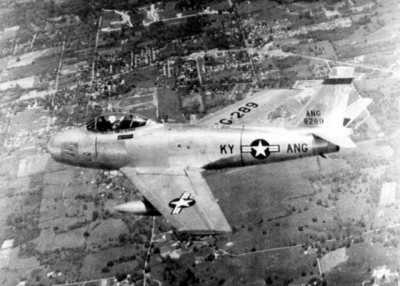
North American F-86A Sabre Jet over the Louisville area 1957-1958. Courtesy Charles Arrington
General Information
- Primary Function
- Fighter
- Contractor
- North American
- Crew
- One
- Unit Cost
- $178,000
- Powerplant
- One General Electric J-47 turbojet of 5,200 lbs thrust
Dimensions
- Length
- 37 ft. 6 in.
- Wingspan
- 37 ft. 1 in.
- Height
- 14 ft. 8 in.
Performance
- Speed
- 685 mph
- Ceiling
- 49,000 ft
- Range
- 1,200 miles
- Armament
- Six .50-cal. machine guns and eight 5 in. rockets or 2,000 lbs. of bombs.
The F-86 was the USAF's first swept-wing jet aircraft.
RB-57 Canberra 1958-1965
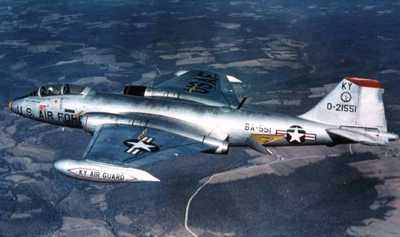
RB-57B Canberra serial number 21551. This particular aircraft is now in the collection of the National Air and Space Museum in Washington, DC and is scheduled for display at the Udvar-Hazy Center. Courtesy Charles Arrington
General Information
- Primary Function
- Bomber
- Contractor
- Martin
- Crew
- 2 (pilot, electronic warfare officer)
- Unit Cost
- $1,264,000
- Powerplant
- Two Wright J65-W-5s or two Buick J65-BW-5s of 7,220 lbs. thrust each
Dimensions
- Length
- 65 ft. 6 in.
- Wingspan
- 64 ft
- Height
- 15 ft. 6 in.
Performance
- Speed
- 570 mph
- Ceiling
- 49,000 ft
- Range
- 2,000 miles
- Armament
- Four 20mm cannons, eight .50 caliber machine guns, up to 5,000 lb of external bombs, and four weapons pylons for bombs or rockets
- Service Life
Service Life
- First Flight
- July 20, 1953
- End of Service
- 1959
- Number Built
- 403 total
The Canberra broke a long-standing tradition for the US of not buying foreign aircraft. The B-57 is based off of the British Electric Canberra.
RF-101 Voodoo 1965-1976
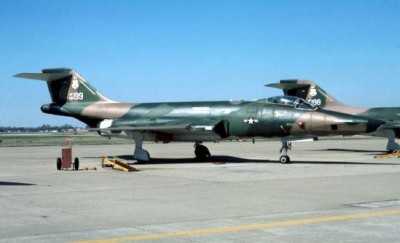
RF-101C Voodoo at the Louisville base during March 1976. Photo by: Charles W. Arrington
General Information
- Primary Function
- Escort/All-weather interceptor / Fighter-Bomber / Reconn.
- Contractor
- McDonnell
- Crew
- One
- Powerplant
- Two Pratt & Whitney J57-P-55 turbojet engines rated at 17,000Lb (7,666Kg) each
Dimensions
- Length
- 67 feet 5 inches
- Wingspan
- 39 feet 8 inches
- Height
- 18 feet
Performance
- Speed
- Max. 1,009 mph
- Ceiling
- 38,900 ft
- Armament
- Four 20 mm cannons, low-altitude bombing systems, 1,620-pound bomb or 3,721-pound nuclear bomb. The F-101 aided in the Cuban missile crisis and Vietnam War.
RF-4C Phantom 1976-1989
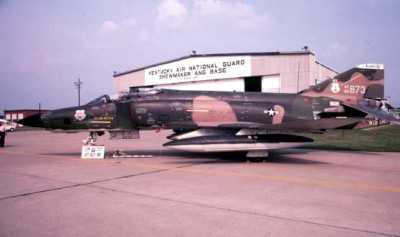
RF-4C Phantom II on display at Shewmaker ANG Base, Louisville during August 1978. Photo by: Charles W. Arrington
General Information
- Primary Function
- All-weather fighter-bomber
- Contractor
- McDonnell Douglas
- Crew
- F-4G -- Two (pilot and electronic warfare officer)
- Unit Cost
- $18.4 million
- Powerplant
- Two J79 General Electric engines rated at 17,900 lb of thrust
Dimensions
- Length
- 62 feet, 11 inches (19.1 meters)
- Wingspan
- 38 feet, 11 inches (11.8 meters)
- Height
- 16 feet, 5 inches (5 meters)
Performance
- Speed
- 1,498 mph at 40,000 ft
- Ceiling
- 60,000 feet (18,182 meters)
- Range
- 1,300 miles (1,130 nautical miles)
- Armament
- Four AIM-7 Sparrow and four AIM-9M Sidewinder missiles, AGM-65 Maverick missiles, AGM-88 HARM missile capability, and one fuselage centerline bomb rack and four pylon bomb racks capable of carrying 12,500 pounds (5,625 kilograms) of general purpose bombs.
The Phantom was the first multi-service aircraft, flying concomitantly with the U.S. Navy, Air Force and Marine Corps. The Phantom was the first and only aircraft to be flown concomitantly by both the Blue Angels and the Thunderbirds. The F-4C first flew for the Air Force in May 1963 and the Air National Guard began flying the F-4C in January 1972. The Air Force Reserve received its first Phantom II in June 1978. The F-4D model, with major changes that increase accuracy in weapons delivery, was delivered to the Air Force in March 1966, to the Air National Guard in 1977, and to the Air Force Reserve in 1980.
The first F-4E was delivered to the Air Force in October 1967. The Air National Guard received its first F-4E in 1985, the Air Force Reserve in 1987. This model, with an additional fuselage fuel tank, leading-edge slats for increased maneuverability, and an improved engine, also has an internally mounted 20mm multi-barrel gun with improved fire-control system.
C-130 Hercules 1989-Present
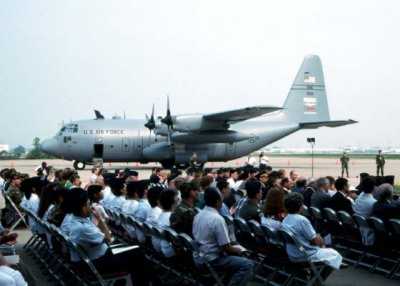
Ceremony in Louisville upon delivery of KYANG`s first C-130H Hercules in May 1992. This factory fresh airplane was the 2000th Hercules built by Lockheed since production started in the 1950s. Photo by: Charles W. Arrington
General Information
- Primary Function
- Tactical and intratheater airlift
- Contractor
- Lockheed
- Crew
- Five (two pilots, a navigator, flight engineer and loadmaster)
- Unit Cost
- C-130J, $48.5 million (FY98 constant dollars)
- Powerplant
- Four Allison T56-A-15 turboprops; 4,300 horsepower, each engine
Dimensions
- Length
- 97 feet, 9 inches (29.3 meters)
- Wingspan
- 132 feet, 7 inches (39.7 meters)
- Height
- 38 feet, 3 inches (11.4 meters)
Performance
- Speed
- 374 mph (Mach 0.57) at 20,000 feet (6,060 meters)
- Ceiling
- 33,000 feet (10,000 meters) with 100,000 pounds (45,000 kilograms) payload
The C-130 Hercules is the West's most widely used and versatile military transport. Using its aft loading ramp and door the C-130 can accommodate a wide variety of oversized cargo, including everything from utility helicopters and six wheeled armored vehicles to standard palletized cargo and military personnel. In an aerial delivery role, it can air drop loads up to 42,000 pounds or use its high-floatation landing gear to land and deliver cargo on rough, dirt strips. The flexible design of the Hercules enables it to be configured for many different missions, allowing for one aircraft to perform the role of many. Much of the special mission equipment added to the Hercules is removable allowing the aircraft to revert back to its cargo delivery role if desired. Additionally, the C-130 can be rapidly reconfigured for the various types of cargo such as palletized equipment, floor loaded material, air drop platforms, container delivery system bundles, vehicles and personnel or aeromedical evacuation.
Four decades have elapsed since the Air Force issued its original design specification, yet the remarkable C-130 remains in production. The initial production model was the C-130A, with four Allison T56-A-11 or -9 turboprops. A total of 219 were ordered and deliveries began in December 1956. The C-130B introduced Allison T56-A-7 turboprops and the first of 134 entered Air Force service in May 1959. Introduced in August of 1962, the 389 C-130E's that were ordered used the same Allison T56-A-7 engine, but added two 1,290 gallon external fuel tanks and an increased maximum takeoff weight capability. June 1974 introduced the first of 308 C-130H's with the more powerful Allison T56-A-15 turboprop engine. Nearly identical to the C-130E externally, the new engine brought major performance improvements to the aircraft.
The latest C-130 to be produced, the C-130J entered the inventory in February 1999. With the noticeable difference of a six bladed composite propeller coupled to a Rolls-Royce AE2100D3 turboprop engine, the C-130J brings substantial performance improvements over all previous models, and has allowed the introduction of the C-130J-30, a stretch version with a 15-foot fuselage extension. Air Force has selected the C-130J-30 to replace retiring C-130E's. Approximately 168 C-130J/J-30s are planned for the inventory. To date, the Air Force has purchased 29 C-130J aircraft from Lockheed Martin Aeronautics Company.
Aircraft specifications courtesy of globalaircraft.org